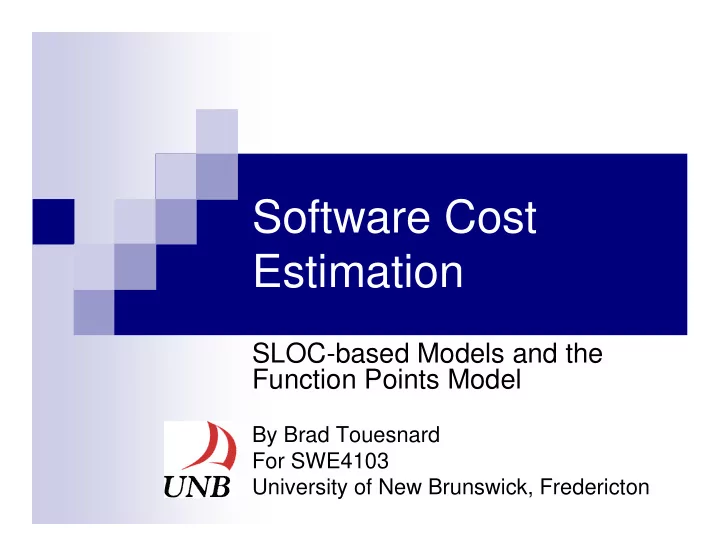

Software Cost Estimation SLOC-based Models and the Function Points Model By Brad Touesnard For SWE4103 University of New Brunswick, Fredericton
Intro SLOC Function Points Conclusion Outline � Introduction � SLOC-based Approach � Function Points Approach � Conclusions
Intro SLOC Function Points Conclusion Introduction � Ad-hoc models initially used � Need for formal estimation model � Lines of code easily understood metric � 1970 – SLIM (Putnam) � 1979 – Function Points (Albrecht) � 1981 – COCOMO (Boehm)
Intro SLOC Function Points Conclusion Wagerline.com � Total Estimated Hours = 76 � 76 x $40 per hour = $3040
Intro SLOC Function Points Conclusion Wagerline.com Function Hours Web site design 10 Database model and creation 10 External data feed integration and creation of individual sports pages 10 Install, setup, customize phpBB forums 4 Home, About Us, Contact Us pages 4 Leader board for each sport 6 Display user’s pending picks 4 Modify user profile 4 Display user profile 4 User registration and login 4 User-defined Pools 16 Create a new pool (4 hrs) Display pool leaders (4 hrs) Make picks for a pool (4 hrs) Display all public pools (4 hrs)
Intro SLOC Function Points Conclusion How do you estimate SLOC? � Experience � Previous system size � Existing system size � Breaking system into pieces From “Schaum's Outline of Software Engineering” by David Gustafson
Intro SLOC Function Points Conclusion How do you estimate SLOC? � For each piece estimate � Smallest possible SLOC - a � Most likely SLOC - m � Largest possible SLOC - b From “Example of an Early Sizing, Cost and Schedule Estimate for an Application Software System” by L. H. Putnam
Intro SLOC Function Points Conclusion How do you estimate SLOC? 4 + + a m b � Expected SLOC for = E i each piece 6 � = E E � Total Expected SLOC i From “Example of an Early Sizing, Cost and Schedule Estimate for an Application Software System” by L. H. Putnam
Intro SLOC Function Points Conclusion SLOC Estimate Example Smallest Most Largest Likely Display user’s pending picks 200 300 500 Modify user profile 100 150 250 Display user profile 250 300 450 User registration and login 200 220 250
Intro SLOC Function Points Conclusion What are function points? � Functions of a software system � 5 Categories � External Input � External Output � Internal File � External Interface � External Inquiry
Intro SLOC Function Points Conclusion What are function points? External System Boundary Inquiries Internal Files External Outputs External Interfaces External Inputs
Intro SLOC Function Points Conclusion Unadjusted Function Points (UFP) Low Avg. High External Input __ x 3 __ x 4 __ x 6 External Output __ x 4 __ x 5 __ x 7 Internal File __ x 7 __ x 10 __ x 15 External Interface __ x 5 __ x 7 __ x 10 External Inquiry __ x 3 __ x 4 __ x 6 3 5 �� = UFP w ij x ij 1 1 = = i j From “Reliability of Function Points Measurement. A Field Experiment,” by Chris F. Kemerer
Intro SLOC Function Points Conclusion Adjusting for Other Factors Data communications 1. 0 – No Influence Distributed functions 2. Performance 3. Heavily used configuration 4. Transaction rate 5. 5 – Very Influential Online data entry 6. End user efficiency 7.
Intro SLOC Function Points Conclusion Adjusting for Other Factors Online update 8. 0 – No Influence Complex processing 9. 10. Reusability 11. Installation ease 12. Operational ease 5 – Very Influential 13. Multiple sites 14. Facilitates change
Intro SLOC Function Points Conclusion Value Adjustment Factor (VAF) 14 � 0 . 65 0 . 01 = + • VAF r i 1 = i where r i is the rating of factor i From “Reliability of Function Points Measurement. A Field Experiment,” by Chris F. Kemerer
Intro SLOC Function Points Conclusion Adjusted Function Points (AFP) = • AFP UFP VAF From “Reliability of Function Points Measurement. A Field Experiment,” by Chris F. Kemerer
Intro SLOC Function Points Conclusion Function Points Model Advantages Disadvantages � Estimation data � Difficult to available early automate data collection � Language and implementation � Possible independent subjective counting of � Non-technical function points estimation
Intro SLOC Function Points Conclusion SLOC-based Models Advantages Disadvantages � Easy to automate � Highly subjective data collection estimate of SLOC � Easy to � Highly dependent understand SLOC on experience concept � Difficult calibration for a non-native environment
Intro SLOC Function Points Conclusion Conclusion ...even the current cost is small relative to the large sums spent on software development and maintenance in total, and managers should consider the time spent on FP collection and analysis as an investment in process improvement of their software development capability.” – Chris F. Kemerer, “Reliability of Function Points Measurement. A Field Experiment”
Intro SLOC Function Points Conclusion Questions?
Recommend
More recommend